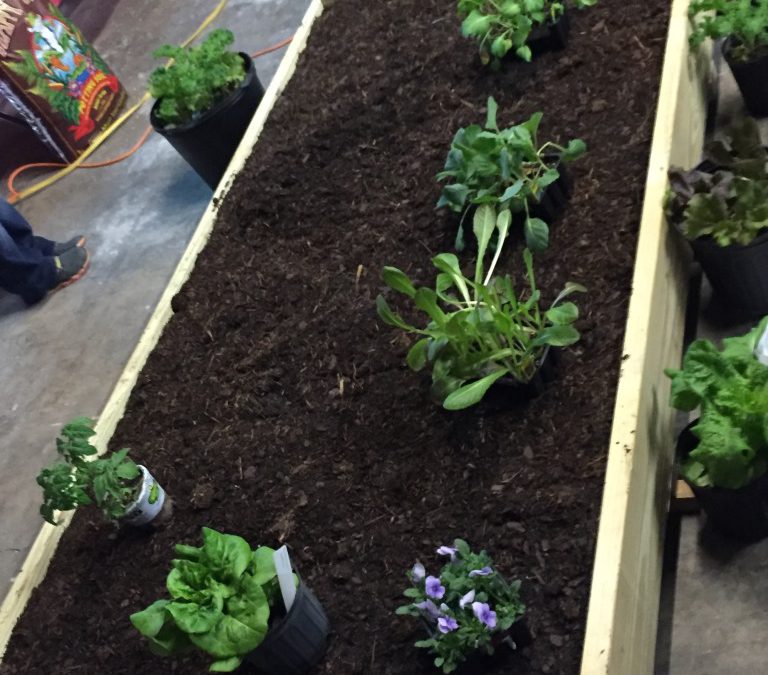
by Molly Jameson | Jan 27, 2020
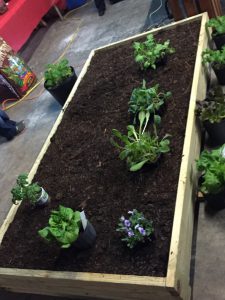
A raised bed container garden , about 8 inches deep. Image Credit Matthew Orwat
Interested in growing vegetable crops but have limited space for a garden bed? Maybe you live in an apartment, have poor soil, or you can’t find a sunny enough location to start an in-ground garden.
The good news is you can grow nearly any crop in a container! Even crops such as beans, squash, watermelon, and sweet potatoes can be grown to maturity and produce high yields if they are grown in properly sized containers with nutritious potting soil.
The Container Gardening: Recommended Varieties and Spacing chart covers the recommended minimum container volume, container depth, plant spacing, and varieties that do well in containers for each crop:
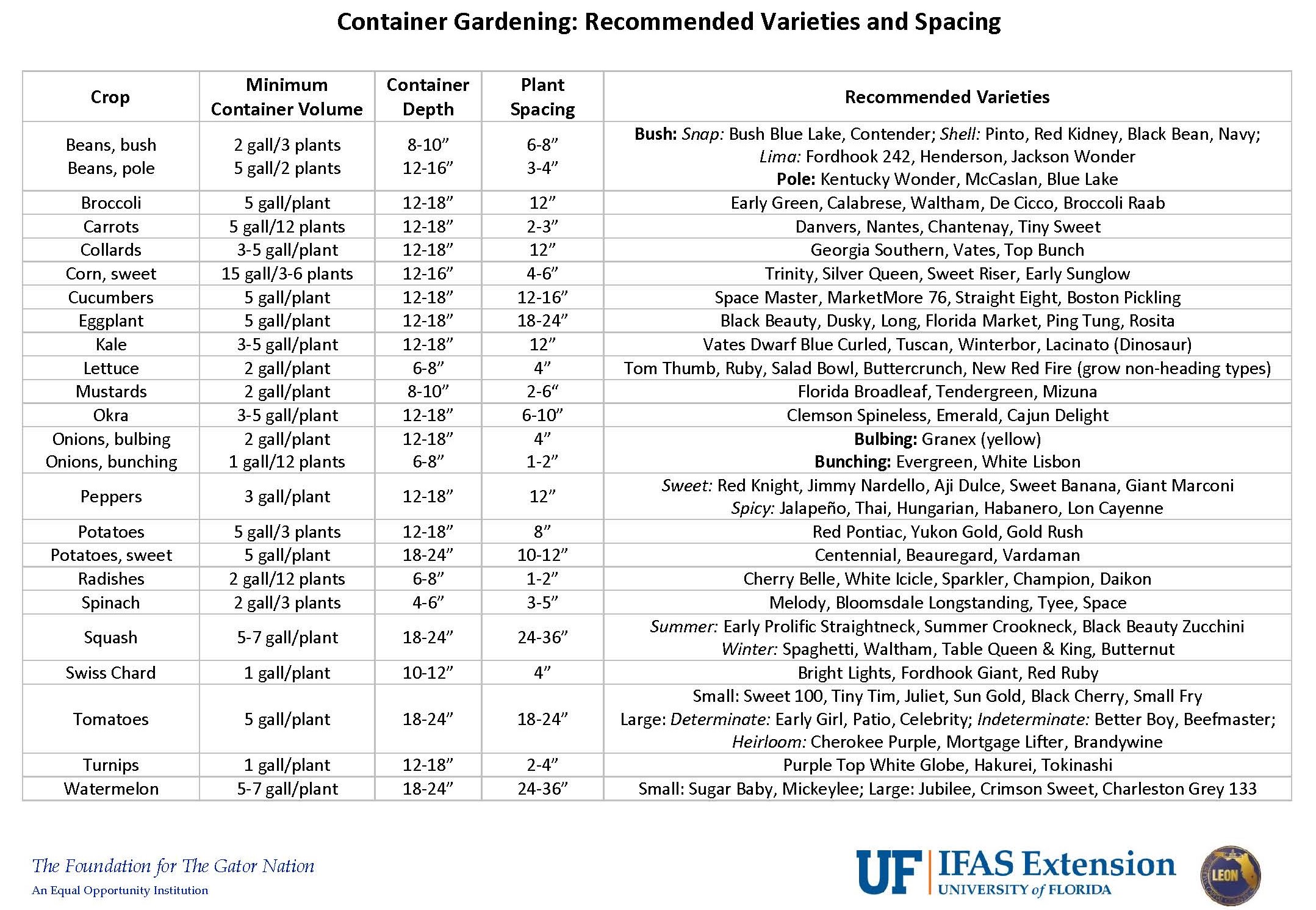
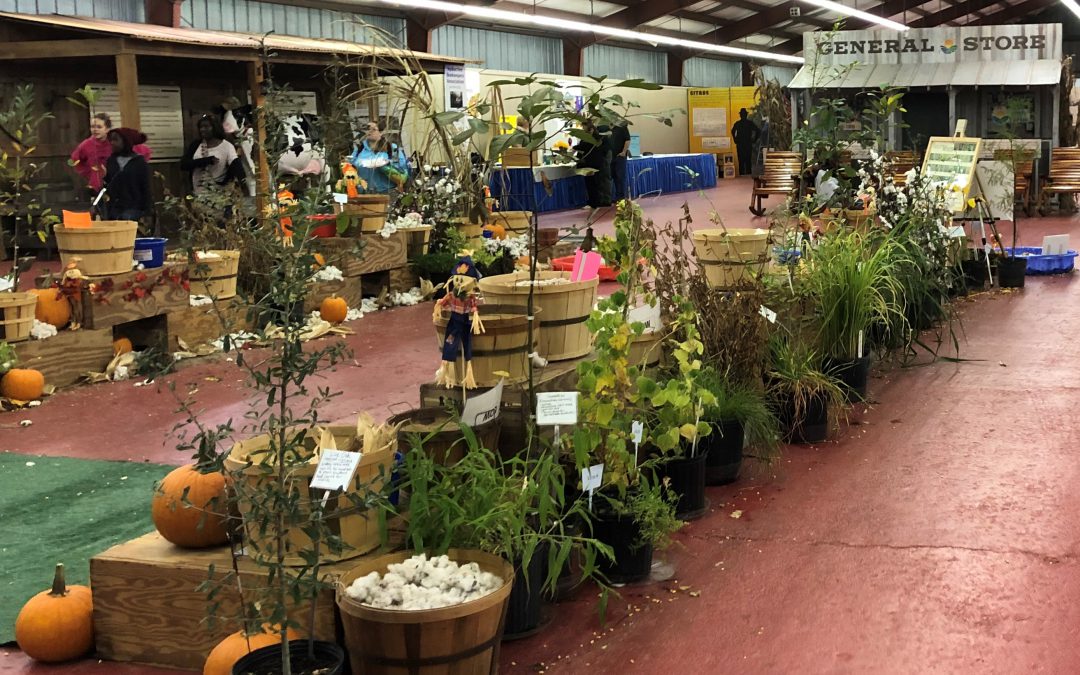
by Molly Jameson | Nov 7, 2019
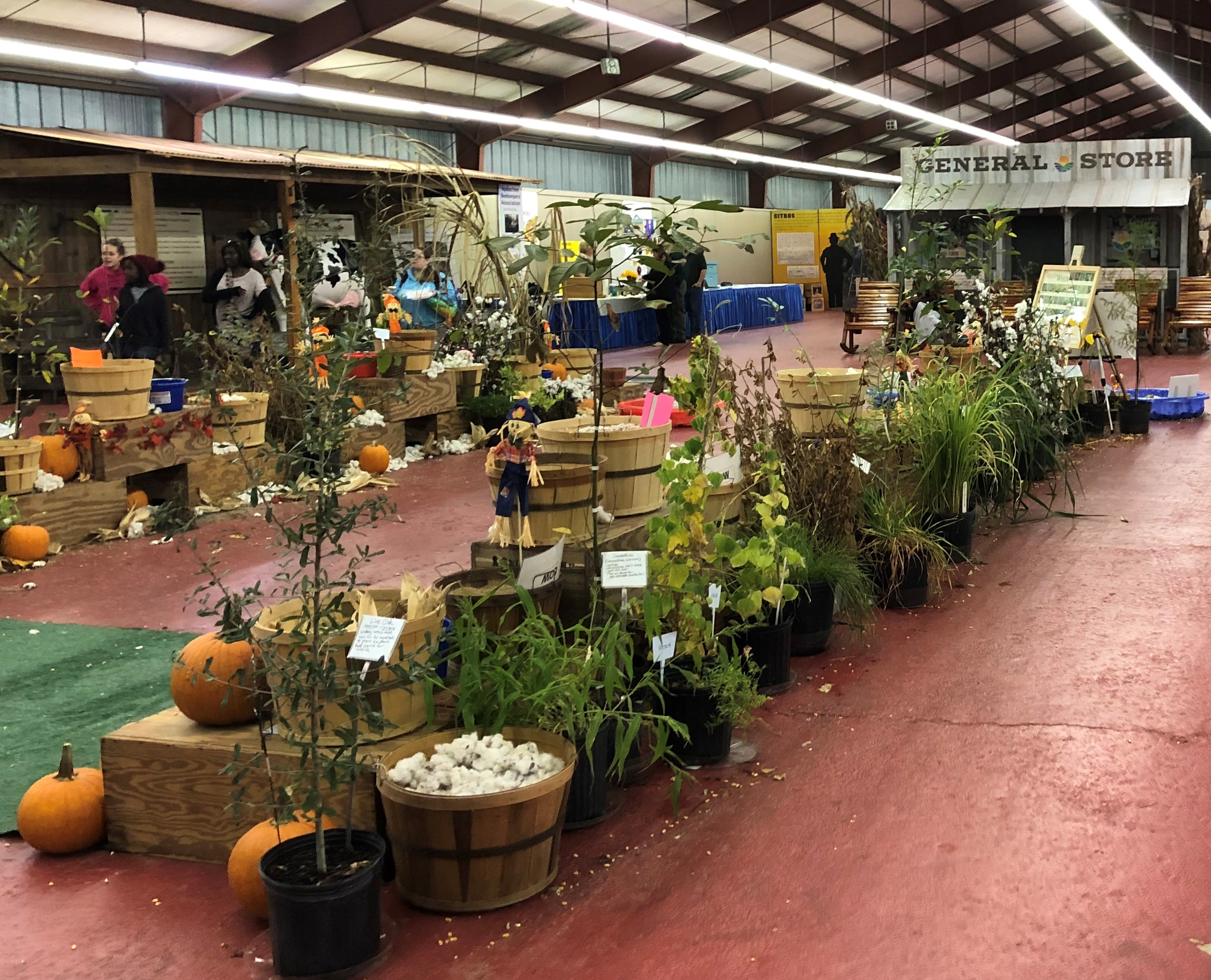
There are hands-on agricultural crop displays and much more in the UF/IFAS building at the North Florida Fair. Photo by Molly Jameson.
New Demonstrations in the UF/IFAS Extension Building at the North Florida Fair
Every year during the North Florida Fair in Tallahassee, extension agents from all over the Florida Panhandle showcase their various programming in the UF/IFAS exhibitor building. This includes educational displays and hands-on activities in areas such as horticulture, agriculture, livestock, 4-H youth, natural resources, and family and consumer sciences.

Once you have your fill of fair rides and funnel cake, see a live educational demonstration at the UF/IFAS building! Photo by Molly Jameson.
For instance, visitors can view and touch agricultural crops grown in our area, play in a giant tub of actual cotton, match images of song birds with their names, make a 4-H craft, and learn about the importance of wildlife habitat for animals.
This year, Extension is including even more to do and learn in the UF/IFAS building. There will be live demonstrations taking place throughout the fair week, which is November 7 to 17 this year.
Did you know you can convert recycled containers, such as milk jugs and soda bottles into self-watering planters? Or that when saltwater reef fishing, if fish are brought to the surface too quickly, it can rupture their organs? Learn all about these concepts and more during the UF/IFAS Extension Live Demonstrations.
UF/IFAS Live Demonstration Schedule:
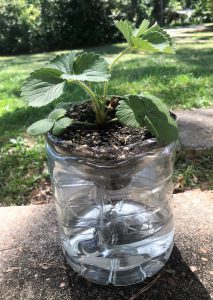
Turn all types of containers into self-watering gardens, such as planting a strawberry in a plastic jug using strips of old cloth as a wick. Photo by John Edwards.
Saturday, November 9:
- 1:00 p.m. – Food Safety with Extension Agent Kendra Zamojski
- 2:00 p.m. – Avoiding Barotrauma while Deep Sea Fishing with Extension Agent Andrea Albertin
Monday, November 11:
- 1:00 p.m. & 4:00 p.m. – Reef Fish Catch and Release Techniques with Extension Agent Laura Tiu
Tuesday, November 12:
- 6:30 p.m. – Rose Propagation with Extension Agent Matt Orwat
Thursday, November 14:
- 6:15 p.m. – Starting Plants in Recycled Newspaper with Extension Agent Paula Davis
- 7:00 p.m. – Food Safety with Extension Agents Laurie Osgood and Amy Mullins
Saturday, November 16:
- 3:00 p.m. – Planting with Recycled Containers with Extension Agents Molly Jameson, Mark Tancig, and Allison Leo
Sunday, November 17:
- 7:00 p.m. & 8:00 p.m. – Reef Fish Catch and Release Techniques with Extension Agent Erik Lovestrand
For more information about the North Florida Fair, visit the website at http://northfloridafair.com/.
See you at the fair!
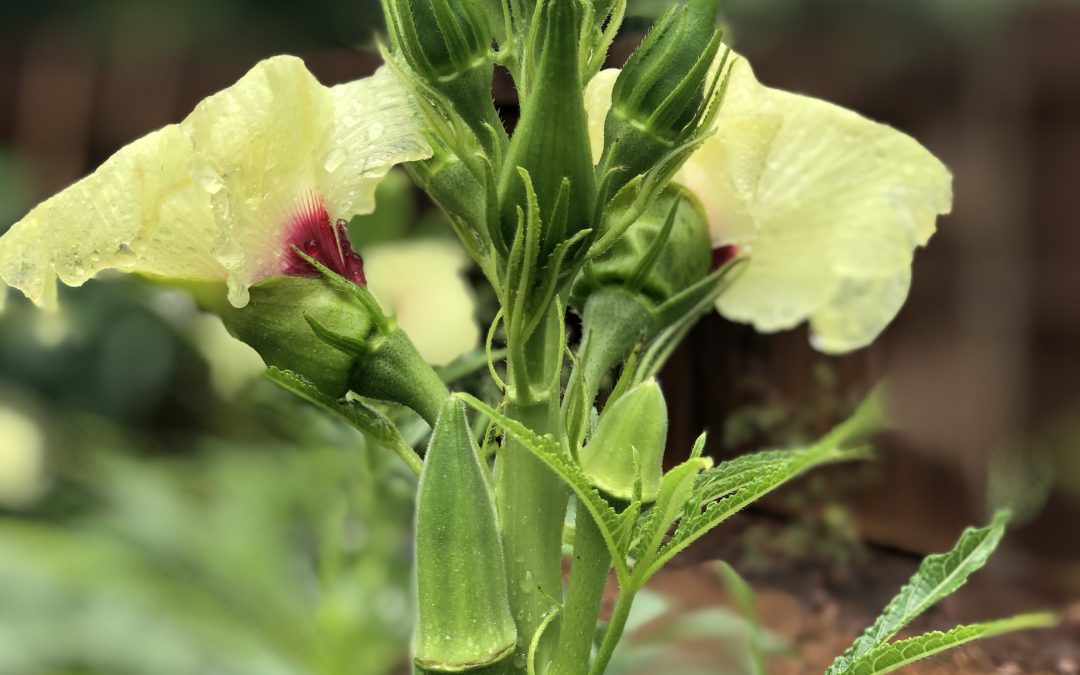
by Daniel J. Leonard | Aug 20, 2019
Though Okra (Abelmoschus esculentus) fruit isn’t much more than a thick green hull, slime and seeds and the plant itself is impossibly irritating to the skin, few plants are as integral to Southern heritage. In my mind, okra is among the best vegetables Panhandle gardeners can grow. Not only is it a gorgeous plant – Okra belongs to the Mallow family which also includes beauties like Hibiscus and Cotton – but it’s exceedingly versatile in the kitchen, excellent fried, grilled, roasted, boiled (though you have to acquire a taste for slimy textures to enjoy this method) and most famously, as a thickening agent in Cajun gumbo. Because of this exalted status in Southern culture, whether you enjoy eating okra or not, it’s almost mandatory here to include the plant in one’s garden. Most gardeners stick with the old standard varieties such as ‘Clemson Spineless’ or ‘Cowhorn’ and there is nothing wrong with them, however, these plants are almost too prolific for most gardens (growing upwards of 6-7’), especially for those of us growing in the close confines of raised beds. In the search for a less rambunctious but still ultra-productive cultivar, this summer I trialed ‘Jambalaya’, an F1 hybrid developed by Sakata Seed in 2012, with impressive results!
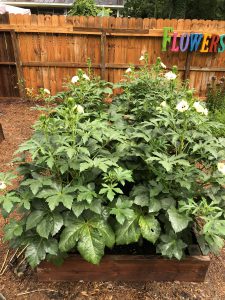
‘Jambalaya’ Okra in the author’s garden.
From my experience growing the cultivar this summer, ‘Jambalaya’ merits consideration in the garden, and is a must for raised bed gardeners, for two primary reasons. First, it was bred to be compact and is considered a dwarf cultivar. This is an awesome attribute, as I typically end the growing season picking okra from a small ladder! Most seed purveyors tout the plant as reaching a maximum height of 3-4’ and while this estimate might be a little conservative, I can attest that ‘Jambalaya’ is greatly reduced in height compared to the standard cultivars. The second advantage of growing this variety is that it begins producing very early relative to its peers and bears heavily. ‘Jambalaya’ fruit begin to ripen in about 50 days, about ten days to two weeks earlier than ‘Clemson Spineless’, a definite advantage if rotating behind a late maturing spring crop like potatoes as I typically do. Though ‘Jambalaya’ is a dwarf plant, in no way are yields reduced. My specimens have produced continuously since late-July and will continue to do so as long as adequate fertility and consistent harvesting are provided.
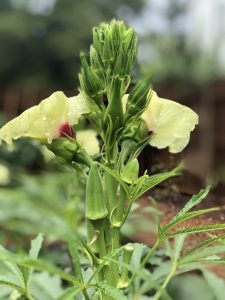
‘Jambalaya’ flower & fruit production.
Like any other okra cultivar, ‘Jambalaya’ has a couple of basic requirements that must be met for plants to thrive. In general, all okra cultivars love Southern summers and patience sowing seed is recommended, allow the soil to warm to at least 70 degrees before planting. Okra also prefers full sun, at least 6 hours per day, any less and yields will be reduced and plants will stretch towards the light. Belonging to the Mallow family, okra requires consistent moisture, particularly when in the flowering and fruiting phase. Finally, it is critical to keep up with your okra harvest as the plants produce! Okra pods grow quickly and should be harvested when they are no more than 3-4” long and still tender, larger pods are tough to the point of being inedible!
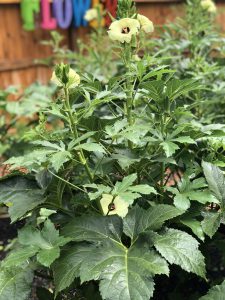
‘Jambalaya’ in the author’s garden.
Whether you’re new to the okra growing game or you’re a seasoned gumbo gardener, I highly encourage you to give ‘Jambalaya’ Okra a look next summer. While ‘Jambalaya’ is available through many seed sources, Johnny’s Selected Seeds sells a conveniently small package perfect for backyard gardeners, though they’ll be happy to provide larger quantities as well. In ‘Jambalaya’ you’ll find a nice compact plant that won’t outgrow your space, provide you a summer long harvest of tender green pods, and will rival the ornamentals in your landscape for the title of prettiest plant on your property! Happy gardening and as always, if you have questions about vegetable gardening or any other horticultural or agronomic topic, please contact your local UF/IFAS County Extension office!
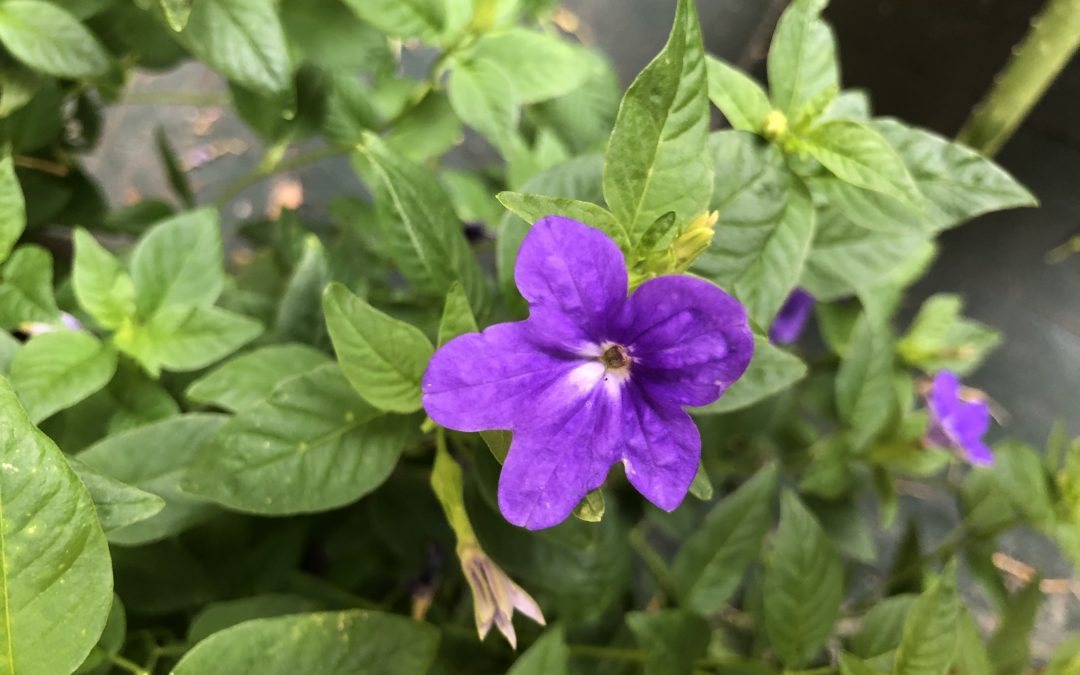
by Daniel J. Leonard | Aug 12, 2019
As an unabashed plant enthusiast who’s been experimenting with new plant introductions (some not really “new”, just new to me) in his own landscape, and his parent’s yard before that (sorry guys for the ‘Charmed Wine’ Oxalis that now pops up unwanted every spring) for nearly two decades now, at this point I’m pretty hard to impress. However, last year Andrea Schnapp, a UF/IFAS Walton County Master Gardener, introduced me to a newish plant that has since changed the way I choose plants to color shady pots and planting beds, a little native of tropical South America called Bush Violet (Browallia spp.), specifically the hybrid ‘Endless Illumination’.
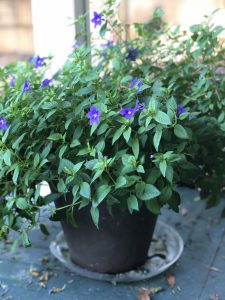
Browallia ‘Endless Illumination’ on the author’s back porch.
For decades, the standard bedding plant for color in the shade in the Deep South has been Impatiens walleriana. However, in the last few years, a new disease called Impatiens Downy Mildew has wreaked habit on the bedding plant species, virtually eliminating it as a serious player in the horticulture industry. Fortunately, the fine folks at Proven Winners introduced ‘Endless Illumination’ a couple of years ago to fill the niche formerly occupied by old-fashioned Impatiens. And boy, is ‘Endless Illumination’ aptly named. The unending masses of star shaped flowers are an absolutely brilliant purple hue that does indeed light up shady areas in the landscape. I’ve encountered few plants put forth such a proliferous display of flowers for as long of a time as this Browallia selection has, and it doesn’t even require deadheading!
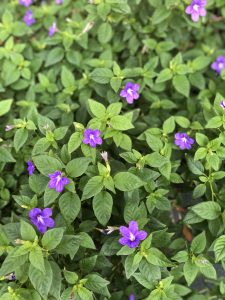
Browallia ‘Endless Illumination’ flowers.
In addition to having one of the more striking color displays of any bedding plant, Browallia happens to be a vigorous grower with an extremely hardy constitution. I’ve found ‘Endless Illumination’s mature size as listed on the sales tag as being a little conservative, instead of the 16” tall x 14” wide stated, my samples have consistently grown more than the 16” listed in height and doubled the width, no complaints here as this just means more flowers! And though my experience with Browallia has strictly been in containers so far, it has weathered heat and bounced back from drought like a champ. It’s not super important to know that the container it occupies is sited under my back porch roof and therefore is subjected to human induced drought by my forgetting to water it, good performance in droughty conditions is good performance in droughty conditions! Finally, Browallia requires the bare minimum of fertilizer to thrive. A good topdressing of a slow-release fertilizer (rates according to the product’s label, of course) at planting and an identical refresher dose mid-summer have induced great performance and no noticeable nutrient deficiencies.
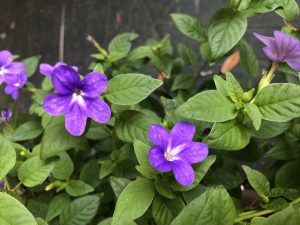
Browallia ‘Endless Illumination’ flowers
A quick note before we adjourn, when perusing nurseries next spring for Browallia, you’ll likely encounter the sister cultivar of ‘Endless Illumination’ with white flowers, named ‘Endless Flirtation’. I’d encourage you to stick with the purple flowers of ‘Endless Illumination’ as I’ve found, through personal growing experience and anecdotes from other growers, ‘Endless Flirtation’ to be noticeably fussier than and not nearly as attractive as its sister plant.
Sometimes, the misfortunes of one plant are a merely an opportunity for another plant to claim its place in the flower bed. Browallia ‘Endless Illumination’ has taken the spot occupied by Impatiens walleriana and quickly become a garden favorite. Look for this awesome little annual in garden centers next spring! And remember, if you have any questions about this newly introduced plant or any other horticultural topic, please contact your local UF/IFAS Extension office! Happy gardening!
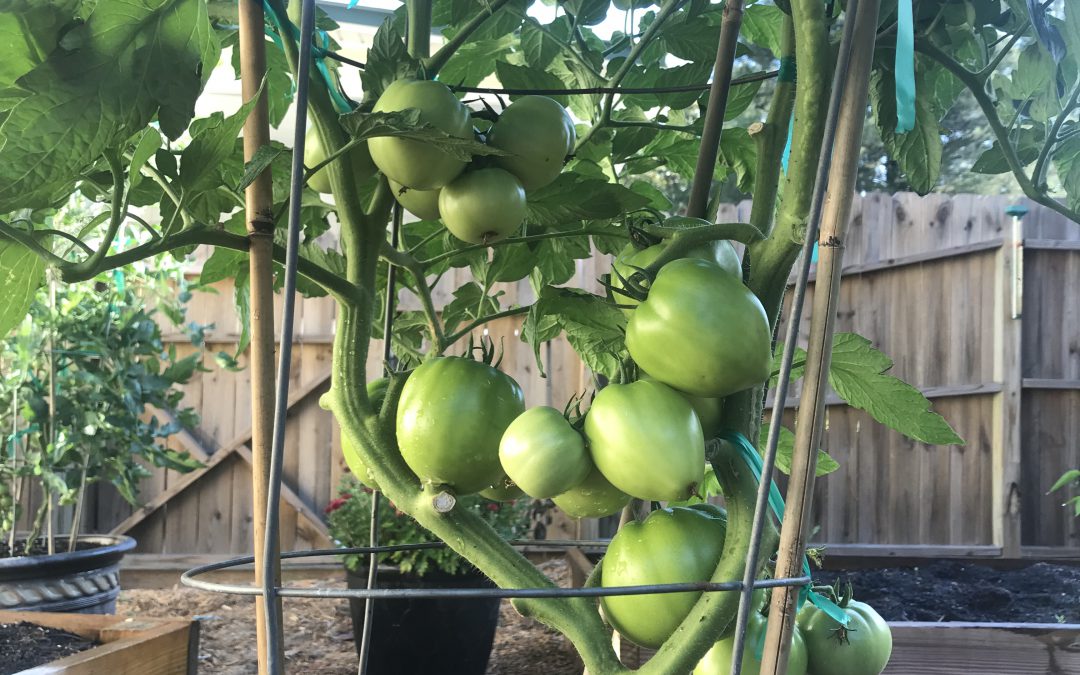
by Daniel J. Leonard | May 27, 2019
Talk to nearly any Panhandle gardener and one of the first things brought up in conversation is the difficulty growing large, beefsteak/slicing tomatoes (Solanum lycopersicum) in their home garden. Large tomatoes are indeed among the more challenging garden vegetables in North Florida, affected by myriad pests, pathogens and abiotic issues. However, giving up growing this garden favorite is unwarranted as success can be had by following a couple of often overlooked, simple steps to ward off potential problems.
Choose Resistant Cultivars – One of the major recent gardening trends is the rise of heirloom veggies, particularly heirloom tomatoes. While many of these varieties certainly are interesting and often possess superior flavor/texture, heirlooms are, as a group, extraordinarily susceptible to disease in our climate. Fortunately for gardeners, there are a number of excellent varieties available with large resistance profiles to many common diseases and a similar taste profile to heirloom favorites! ‘Big Beef’ (pictured), ‘Better Boy’, ‘Celebrity’, and ‘Skyway’ are just a few of the many great cultivars with extensive disease resistance available as transplants at garden centers or as seed from quality online seed vendors.
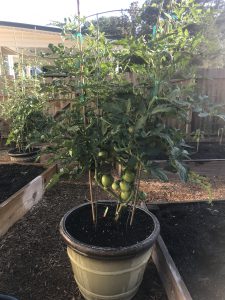
Tomato ‘Big Beef’ in 15 gallon decorative container
Start Early – Once, you’ve selected the proper cultivar, the next key is to get them in the ground early! I’m convinced one of the primary reasons folks fail with tomatoes is waiting for “traditional” garden planting dates. For instance, an old tradition in the South is to plant your garden on Good Friday before Easter. However, according to Johnny’s Selected Seeds Southeast Sales Representative Blake Thaxton, tomatoes should be germinated and growing in the garden no later than March 15. Mr. Thaxton notes two primary reasons for this, the most important being pest/disease avoidance. Beefsteak tomato varieties take around 70 days from planting to harvest, so a March 15th planting date yields ripe tomatoes around the third or fourth week of May, when pest/disease pressure is still manageable. Pests and disease occurrence becomes exponentially worse in the Panhandle as May trickles into June and July, therefore it is critical that your fruit begin ripening prior to this onslaught. An important second motivation to plant early is that tomatoes stop setting fruit when nighttime temperatures rise above 75°F. At these temperatures, tomato pollen is rendered sterile and though the plant will continue flowering, no fruit will be set.
Mulch – Another overlooked best management practice in backyard veggie gardening is mulching! Those of us who tend flower beds already know many benefits of mulch like soil temperature moderation, weed prevention, and moisture conservation. But for tomato growers, mulch has another benefit – disease prevention! Several serious diseases that affect tomato are soil-borne pathogens (i.e. Early Blight, Late Blight, Bacterial Spot, etc.). These pathogens find their way onto plants either indirectly via water splashing from soil onto leaves or direct contact from leaves and fruit resting on the soil. To prevent these pathogens from infecting plant tissue, apply an organic mulch (preferably wheat straw or tree leaves) under and around plants. This simple step goes a long way toward season-long, yield-saving disease prevention.
Consistent Watering – Everyone knows plants need water but what you might not know is that irrigation consistency makes a huge difference in plant health, particularly tomatoes. Consistent watering is key in helping ward off one of the most frustrating tomato maladies, blossom end rot (BER) – you know, the one where the bottom end of your perfectly good tomato fruit turns to a brownish mush! Though BER is caused by calcium deficiency, the condition is commonly induced by creation of distinct wet and dry periods from non-regular watering, interfering with calcium uptake and availability to the plant. So, while you may have adequate soil calcium, if you don’t water correctly, the condition will happen anyway! It’s also good to keep in mind that mature tomato plants use large quantities of water daily, so during the heat of summer, plants in containers may need to be watered multiple times daily to maintain consistently moist soil. Think about it, you don’t drink 8 glasses of water when you wake up and then never drink again throughout a hot day. A tomato is no different. Allowing your plants to wilt down before providing additional water ruins productivity and can induce BER.
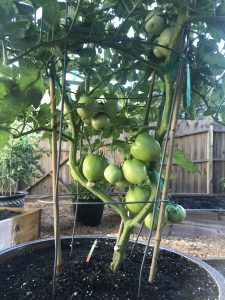
Tomato ‘Big Beef’ demonstrating pruning for soil clearance and airflow.
Pruning – I get it. Once you’ve nursed your baby tomato from a wee transplant or seed into a rapidly growing and flowering plant, it seems counter-intuitive to break out the pruners, but to keep your tomato plant as healthy as possible for as long as possible, that is what you must do! Pruning tomatoes should accomplish two things. First, remove the bottom layer of foliage from the plant base, so that water will not readily splash onto the lowest remaining leaves. (I tend to remove all leaves up to the second set of flowers 8-12” from the soil’s surface.) As with mulching, this prevents bacterial and fungal pathogens from spreading easily from the soil surface onto your plant. Second, tomato plants, especially the vigorous indeterminate varieties, often grow more foliage than is necessary for fruit production. This excess foliage can prevent airflow and trap moisture in the canopy of the plant, promoting disease. To open up the canopy and allow for more airflow, I prune off leaves that grow from the primary stems inward to the center of the plant. The idea is to keep the inside of the plant open while allowing enough leaves to power photosynthesis and shade the developing fruit below.
Tomatoes are notoriously hard to grow, but by following a few easy preventative practices, gardeners can greatly increase their chances of realizing harvestable fruit come summer. Please keep in mind that this is not an exhaustive list that will ensure disease-free plants over the entire growing season (you should also get a soil test to make sure your pH and soil fertility are correct and ideally you’d never work in your tomatoes when they are wet, etc., but this is a good place to start!). However, a little bit of planning and prevention early in the season can make growing tomatoes a lot less frustrating! As always, if you have questions regarding tomatoes or any other horticultural topic, please contact your local UF/IFAS Extension Office. Happy gardening!

by Matt Lollar | May 27, 2019
Nobody likes weeds in their garden. Weeds are not only ugly, they can host insects and diseases that later spread to your garden. This situation commonly occurs when weeds belong to the same plant family as the desired landscape or vegetable species, but some insects and diseases have diverse palettes. For example, I recently witnessed a looper caterpillar on a pokeweed plant.
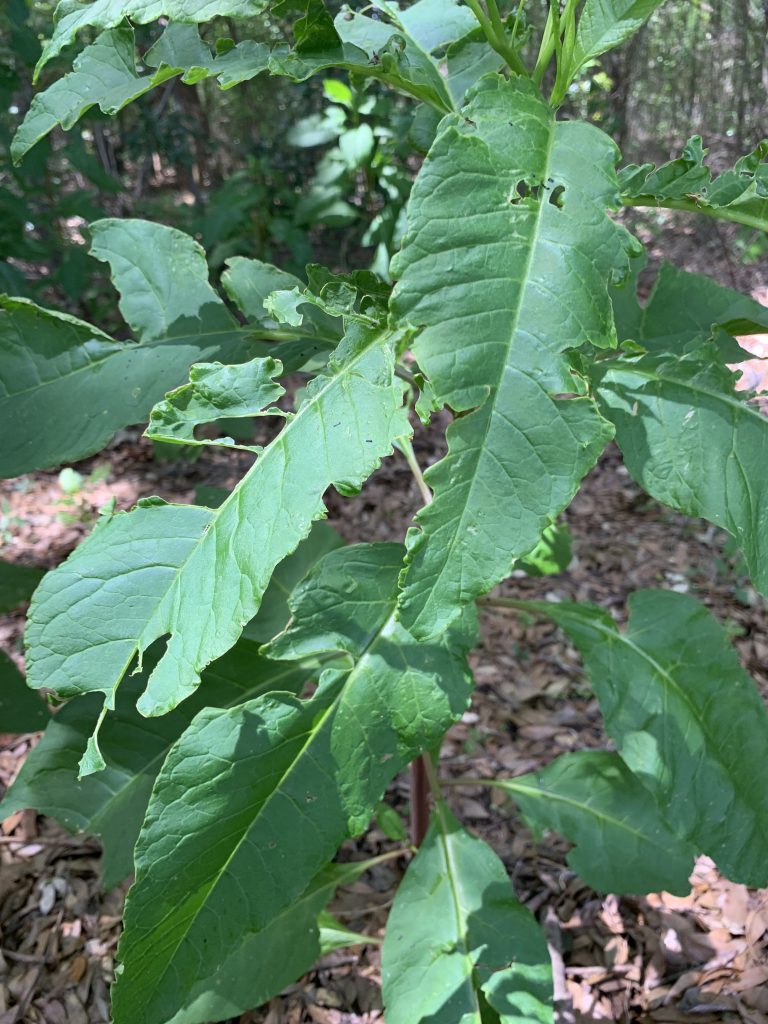
Looper damage on a pokeweed plant. Photo Credit: Matt Lollar, University of Florida/IFAS Extension at Santa Rosa County
Loopers are common pests of vegetable gardens and in the landscape. Probably the most common loopers found in North Florida gardens are cabbage loopers (Trichoplusia ni) and soybean loopers (Chrysodeixis includens). Cabbage loopers can be found feeding on cabbage, of course, as well as leafy greens, cucumbers, tomatoes, chrysanthemums, and snapdragons. Weeds that attract this looper are lambsquarters, dandelions, and curly dock. Soybean loopers like to feed on sweet potatoes, tomatoes, watermelons, geraniums, and sunflowers. They can also be found feeding on oxalis, kutzu, and lantana.
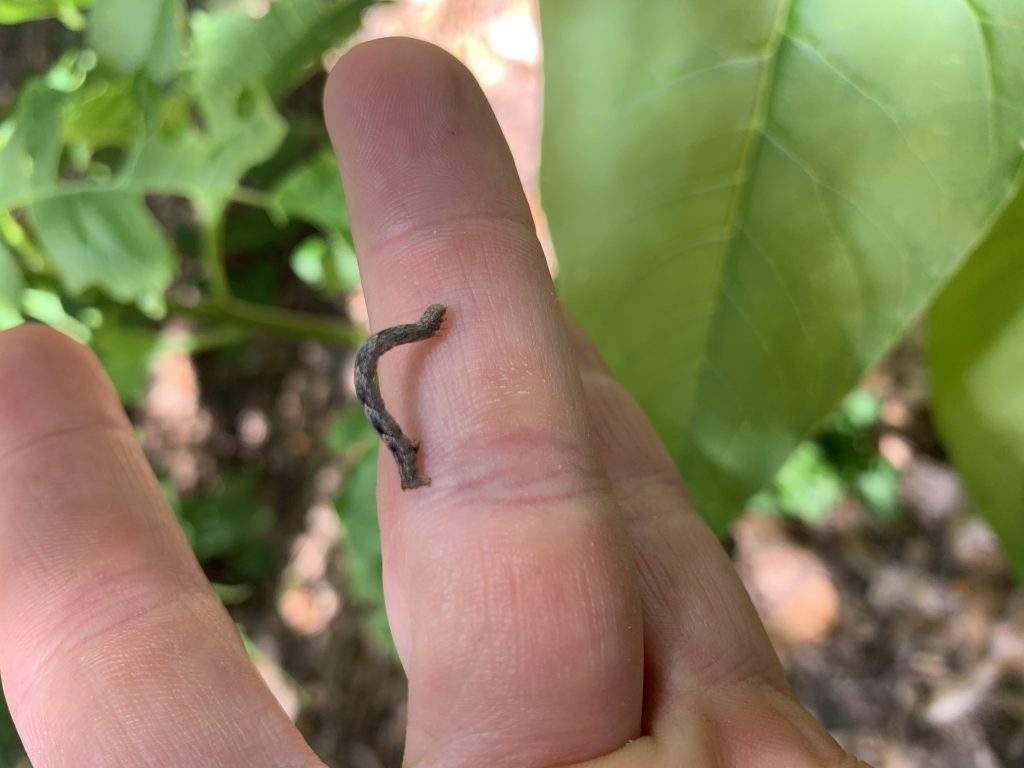
Looper found on pokeweed plant. Photo Credit: Matt Lollar, University of Florida/IFAS Extension at Santa Rosa County
Although weeds can be hosts for pests, they may be used advantageously. Trap crops can be planted at a garden’s perimeter or windward portion to attract pests away from the desired crop. A trap crop draws the pest crop away from the main crop. The trap crop is then destroyed or sprayed with insecticide when the pest insect is found feeding on it. This allows for a reduction or elimination of insecticidal use on the desired crop. However, it is important that both the trap crop and the desired food crop or ornamental crop are regularly scouted to keep track of pest populations.
For more information on trap crops and other insect and disease diversion methods you can read the EDIS Publication: Intercropping, Crop Diversity and Pest Management.





















